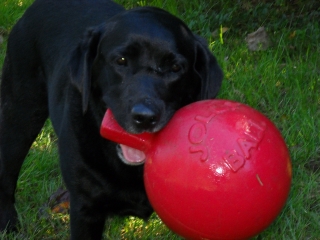Wait For That Behavior

Talley, my 5 year old bouncy anxious English Lab inspired me to get busy and write. When excited or anxious, which is often due to her temperament, she becomes, well…..bouncy! (all three labs give me plenty of scope for practice.) This behavior has been quite consistent over the five years of her loveable short stocky labbie life, and is unlikely to change. True to form this morning, excited by an impending trip to the pond, there was much bouncy bouncy behavior at the backyard gate, the magic gate to freedom. Talley knows the drill, which is why I wait for the desired behavior to happen.
The routine at the gate is unvaried; each dog needs be sitting calmly before leashes go on, and they are invited in turn to exit the yard. When a behavior is reinforced often enough, dogs will offer that behavior. As well, over time, the gate has been associated with the behavior of sitting and leashes going on. Still, Talley unfailingly begins with the bouncy behavior, consistent with her excitable little self. However, she knows that bouncy means not leaving the yard. Why ask for a sit when your dog knows what is really required? Typically, moving away from Talley and waiting prompts the desired behavior. (meanwhile Bridget and Doobie are sitting, leashed and waiting.)
Dogs get it when their opportunity for reinforcement has been removed: technically negative punishment. At that moment in time, Talley wanted more than anything in the world to get through that gate. By moving away with the leash, the opportunity for access to the world beyond the gate was removed. The process of waiting for behavior also allows a dog the opportunity to self calm. We call it impulse control. Talley gains control over her excited bouncy behavior. Turning back and putting on the leash for a calm sit is an extremely powerful life reinforcement for Talley. Why verbalize that cue when behavior will happen just by waiting for the correct response?
Teaching an automatic sit, as in my classes, is another example of how waiting for the desired behavior is very powerful. We first teach sit, yes, using a verbal cue, and reinforce many many times; sit becomes a wonderful thing! We can turn and look at a puppy and sit happens. I love when my demo pups, first night of class, begin sitting automatically in very short order, and owners are just amazed, as though it were magic. Approaching a bouncy puppy, being held on the end of a loose leash, the same principle applies. Pup becomes jumpy? Turn away. Wait. Reinforcement removed. Walk back and pup sits? Reinforce that offered behavior!
Instead of cueing sit at the door, try waiting. Walk away. Wait a bit more. I bet that sit will happen. As a side note, some dogs are so overly aroused by the appearance of a leash predicting outside, that desensitization to the leash is required, before you could expect an improvement in behavior. Also, could I repeatedly take Talley to the gate, cue sit, then reinforce the correct response? Surely I could, with probably a first cue response each time, but the situation would be out of context to the usual gathering of all three labs at the gate, paired with leashes going on. I am actually quite happy with her responses. Thanks for tuning in to my rainy morning rambling. The subject of my blog has been snoring loudly nearby while I wrote. Doobie and Bridget are also snoozing. The author also feels like doing the same, on this chilly rainy day.
Until next time,
Leslie and the labbies.




